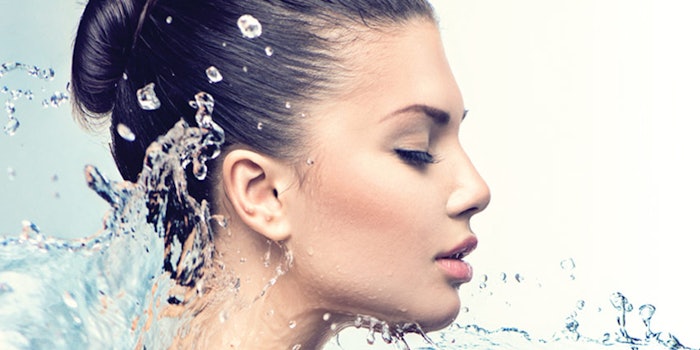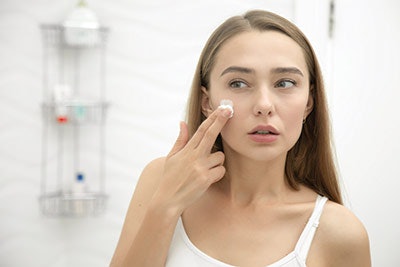
A competent understanding of the range of skin types is something that develops quickly once working in the field. Oily, dry and combination becomes second nature to differentiate; however, knowing only a client’s skin type is doing you both a disservice. Skin conditions are a hefty variable in one’s treatment and requires a deeper interest and understanding of skin. The skin condition “dehydrated”and the skin type “dry” are easily disguised as one another, and yes, there is a major difference between them.
Dehydrated skin is one of the most common yet misunderstood skin conditions, and to the untrained eye it will present itself as dry skin. Overlooking this difference can cost you, your client, your business and even our industry some grief. This is because the worst way to treat dehydrated skin is as if it is dry, which causes the client more problems than they had before they saw you. It also breaks our wall of credibility between our expertise and the public. Oil relieves dry skin, but water relieves dehydrated skin. A client may be one or both but should never be confused for dry or neither if dehydrated.
Causes and Signs
Dehydration is the lack of water in the skin, coupled with a stripped acid mantle. It is the one condition that you either have some confusion about or may be one of the few who has a true understanding of it. Remembering that skin types change little throughout life and skin conditions are a variable based on what a person is or isn’t doing is an important lesson to review. Specifically, the cause of dehydration is more closely related to extrinsic factors such as the misuse of products, lack of products and environmental causes. This, like all conditions, is possible to change through treatment and education.
Understand that dehydration of the epidermis doesn’t necessarily mean the client isn’t drinking enough water because this will be the first thing your client announces when you begin explaining their skin condition to them. Drinking more water won’t fix it, and you don’t want to lose them in your discussion by letting them decide they will drink more water to correct the problem. If they do interject with that, discuss that while drinking enough water is important, the superficial layers of the skin are last in line after the other organs of the body to reap the benefits of water.
The most foretelling sign of dehydration in a client happens before you even analyze their skin. It is the client who tells you that they have “tried everything” and have had no success. Clinical signs of dehydration are evident by a cellophane look to the skin—crinkly and flaky, but shiny. This is apparent especially when the client is oily and dehydrated, since the oily layer is trapped under flaky dead skin.
Misdiagnosis and Its Effects

When a client self-diagnoses or entrusts the advice of a misdiagnosis, it happens because they describe having dry skin and end up with a heavy moisturizer, or they focus on the relentless breakouts and utilize a harsh acne kit. The heavy cream will only sit on top of a layer of dead skin causing them to report a greasy feeling and resulting in no hydration relief combined with breakout activity that is the same or worse.
In acne, the use of an acne kit may initially clear up some of the activity, but it will ultimately result in a stripped acid mantle and extreme dehydration causing more breakouts, especially cystic, as well as the other conditions mentioned previously. This cycle is what breaks trust between the client and our industry.
If a dehydrated client is given a cream for a “dry” skin, it creates a cycle of breakouts due to inadequate treatment since the client’s oil content is sufficient, yet the water content is deprived. Even if the client’s skin type is dry, the benefits of a cream will not properly penetrate through the layer of dehydrated skin, so precise customization is imperative.
Left untreated, dehydration can cause more damage to the skin than dry skin ever will. Signs of dehydration are actually also byproducts caused by being left untreated for too long. You may discover milia, especially in the forehead, orbital and zygomatic region; “sticking” lines of expression; a specific combination of blackheads; and cystic papules. You may also note the presence of fine lines and wrinkles due to rapid destruction of collagen and elastin fibers and sensitized, inflamed skin, which kick starts the breakdown of these fibers.
Breakouts and Dehydration
Breakouts due to dehydration are harder to treat only because they require a great deal of trust from clients. Clients may be afraid to trust your advice, like implementing a moisturizer, due to negative past experiences. Discussing with them that an oil-free moisturizer and a water binding serum is much different than a moisturizer containing oil for dry skin will get your foot in the door.
Inflammation and Sensitization
You may also notice inflammation of the skin in a dehydrated client, and they may claim to be sensitive. This often adds to their resistance, not realizing that they are actually sensitized from the effects of dehydration. They may also experience inflammation from photosensitivity due to acne fighting ingredients in their products and the fear of using SPF.
Sensitization is one of the worst outcomes of dehydration because the inflammation occurring signals matrix metalloproteinases (MMPs) to destroy collagen fibers in the skin, prematurely aging the skin. This occurrence also keeps histamine continuously filling vesicles and increasing the chance of your client infecting the area by picking. As always with treatments, inflammation is the first to get under control. Stressing the importance of changing a few habits to your client to see a reduction in inflammation will lead them to reducing other side-effects as well.
Communicating Dehydration

Once our brains light up with all this exciting information, we need to simplify it in an effective way to get our clients on board without overwhelming them. Developing a simple, conversational script is imperative. Start with one of the following intuitive questions.
Have you used moisturizers and felt it made your skin worse?
Does your skin feel itchy, tight, flaky and/or inflamed in the morning or when you get out of the shower?
Chances are they will say yes to questions of this nature, and it will get their attention. After this, continue telling them more about your findings. For example, “Your skin type is _____ but what’s happening with your skin actually involves a common skin condition which has little to do with your skin type. What you’re experiencing wreaks a lot of havoc on your skin, doesn’t resolve itself and is the hardest to diagnose to the untrained eye, which is why you’ve been having trouble for so long. But, I know what it is, and it is the easiest to correct. The condition is the lack of water in the cells of your outermost layer of skin and is called dehydration, which makes it feel “dry.” Drinking more water won’t fix it, but tweaking your habits and adding a specific serum will.”
Engage in a conversation with them that turns on a light bulb about why recommendations haven’t worked for them before and confirm what you’re saying makes sense to them before continuing. Discuss how unlike skin types, skin conditions are variables and can be modified through habits and specialty products like serums. “Treating your skin for dehydration means improving your water content without adding unnecessary oil. The use of hyaluronic acid binds 1000x its weight in water to your skin without oil which will avoid breakouts but leave your skin feeling great.”
Treating Dehydration
Start with an easy solution and one product. Introducing hyaluronic acid in your script is key because chances are it’s something they haven’t tried yet and your recommendation back with your script will make sense. Explain the miracle molecule further by adding how it is naturally occurring in the body (sclera and joints) and not a burning “acid” as its name implies. It can truly be the one and only product a client needs to treat dehydration specifically.
In addition, tweak their home care by nixing harsh products like foaming cleansers, full acne lines and sunscreens with irritating ingredients. Also, limit exfoliation to one time a week. Have them cleanse their skin with lukewarm water and a washcloth over a sink, and advise them to keep their face as dry as possible in the shower. Acknowledge that this seems like bizarre advice, but affirm they will see improvement. If a client is dehydrated and their skin type is dry, make sure you treat for both.

Know the Difference
Recognizing the signs of dehydration and listening to your client’s history will quickly tell you whether or not your client is dehydrated, dry or both and aid you in treating accordingly. By knowing the difference between dehydrated and dry, you are able to make a change for clients and yourself, supplementing your esthetic career with an immeasurable advancement both in finances and reputation.












